ber 12, 20
Click on the article title below to be taken directly to the article. After you’re done reading the article, click “Back to Top” at the bottom to be brought back to the Table of Contents.
Table of Contents
- NAAA and NAAREF Boards Accomplish Necessary Work at Meetings with Northern Canadian Neighbors
- Ray Starling to Speak at 2025 Ag Aviation Expo Kickoff Breakfast
- Air Tractor the Leading Global Producer of Turboprop Aircraft
- Ag Aviation’s Total Accident Rate Continues to Decline but Fatal Accident Rate Holds Level
- NAAA Staff Member Amy May recognized with Distinguished Service Award at NATA
- Nominations Open for the 2025 NAAA Awards!
- AD Issued for Various Piper Models’ Rudder Post
NAAA and NAAREF Boards Accomplish Necessary Work at Meetings with Northern Canadian Neighbors
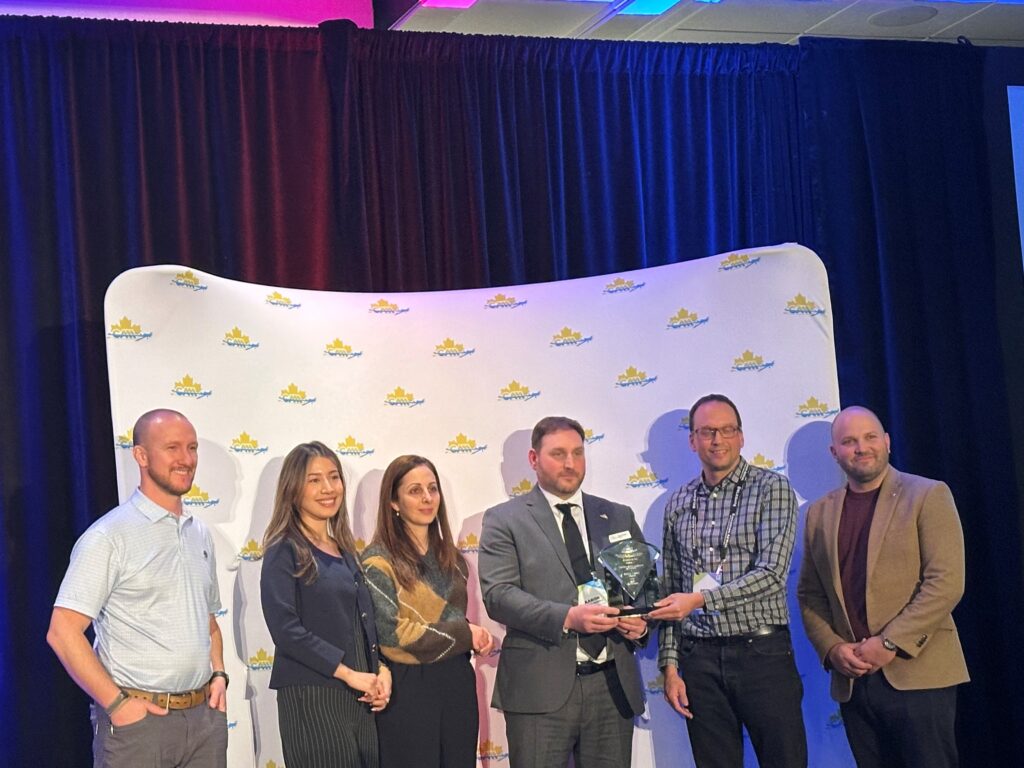
The National Agricultural Aviation Association and National Agricultural Aviation Research and Education Foundation’s boards and committees met last week in Montreal, Canada, holding meetings simultaneously with the annual convention of the Canadian Aerial Applicators Association (CAAA). For decades, the CAAA has held their board meetings during NAAA’s annual convention. NAAA, in the spirit of cooperation with its neighborly, northern brethren decided to do the same.
Substantive business was conducted at the meetings including a tour of Pratt & Whitney Canada’s headquarters and engine manufacturing plant in Longueil, Quebec and a most hospitable welcome party offered to the Canadian and American ag aviation industry representatives offered by the international aircraft engine company.
The NAAA board meeting commenced the morning of February 21st with 2025 President Mike Rivenbark calling the meeting to order and approving board committee members. He introduced Andrew Moore who gave a report on the state of the industry/association.
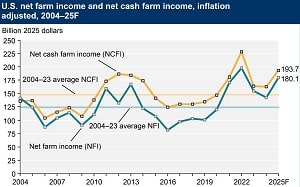
NAAA State of the Industry/Association Report
Moore began with a rundown on the economics surrounding United States agriculture starting with USDA estimates that 2024 U.S. net farm income was $140 billion, down 6.8% from 2023. U.S. net farm income has been upwardly increasing from 2016-2022. On the positive side USDA estimates 2025 U.S. net farm income to increase due to a staggering 345% increase in government payments from a recently enacted disaster relief bill (from $9.3 billion in 2024 to $42.4 billion in 2025). On another positive note he stated that according to a recent survey of U.S. farmers taken earlier this month from the Purdue Center for Commercial Agriculture, farmers’ sentiment about the agricultural economy is higher than it has been since May of 2021 due to a majority of ag producers surveyed believing they expect a lightening of restrictive environmental regulatory policy for agriculture in the upcoming five years, as well as more favorable tax policies following the recent election. Conversely, producers responding to the survey are worried about agricultural trade, with over two-fifths of survey respondents saying they think a ‘trade war’ is either likely or very likely.” Moreover, 56% of Farm Journal’s December 2024 survey of 70 leading ag economists believe an ag recession currently exists; 81% believe the U.S. is on the brink of one. One of the likely reasons, stated Moore, is based on U.S. agricultural trade data. USDA estimated U.S. 2024 ag exports decreased by $4.7 billion to $148.3 billion compared to 2023’s $153 billion. In addition, the $10.9 billion 2023 U.S. ag trade imbalance with all other nations (ag imports vs. ag exports) grew to $23.3 billion in 2024 and is forecast to be a $42.5 billion deficit this year. Experts attribute this to rising protectionism globally and an anemic attempt by the previous Biden administration to find new global ag markets.
Moore provided an overview of U.S. ag trade from President Trump’s first administration (Trump 1.0) to the present to try to predict the future direction of U.S. agricultural trade using China, the number one purchaser of U.S. ag exports (17%), as an example. In 2018, U.S. farmers were hit by China’s retaliatory tariffs on U.S. ag exports to their country after President Trump implemented tariffs and trade barriers on the Chinese due to unfair trade practices and intellectual property theft. According to the American Farm Bureau Federation ag exports from the U.S. to China decreased from $24 billion in 2014 to $9.1 billion in 2018. Trump, in an effort to aid U.S. farmers, directed USDA Commodity Credit Corporation payments to farmers harmed by the tariffs. At the eve of Trump’s second administration, the 2024 overall Chinese trade surplus with the U.S. totaled a whopping $992 billion. Trump recently enacted a 10% tariff on Chinese imports, and tariffs on key ally trade partners. China has retaliated with tariffs on U.S. coal and liquified natural gas and has raised the dispute with the World Trade Organization. Since Trump 1.0, China has since accessed alternative markets for ag products in the European Union and BRICS’ (Brazil, Russia, India, China, and South Africa) nations. Today 24.85% of China’s ag imports come from Brazil ($58.6 billion vs. $33.75 billion of China’s U.S. ag imports). Fifty percent (50%) of Brazil’s total trade is with China. Furthermore, China is making long-term investments with BRICS nations. In 2023 alone it invested $380 billion into those four nations in the form of ports, railroads, and other key pieces of infrastructure, while U.S. foreign investment in the form of economic development, humanitarian and health aid, etc. totaled $65 billion, according to The Wall Street Journal. Moore stated that President Trump is known for his bluster to fluster his negotiating opponents and for penning the “Art of the Deal,” emphasizing that he has an ability to bring parties to the negotiating table and strike hard bargains, yet the savvy of China’s power and investment and Brazil’s agricultural strength mustn’t be ignored.
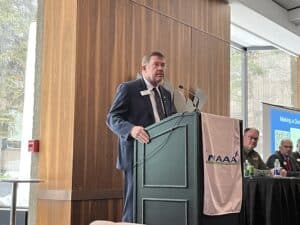
Moore then shifted to government policy issues. He reiterated that NAAA’s most important issue continues to be ensuring the registration of pesticides for aerial use and that pesticide label language for aerial use is not unnecessarily burdensome. Every 15 years, according to federal law, every pesticide product registered in the U.S. must be reevaluated for safety by EPA before reregistration is approved. Since 2017 NAAA has commented on nearly 300 EPA pesticide reviews. According to the National Institute of Environmental Health Sciences, there are over 800 pesticides registered for use in the U.S. NAAA uses a variety of means to ensure aerial use remains available including developing a comprehensive industry survey once or twice a decade about types of equipment used in the industry, acres treated per day per aircraft, etc. The real, actual data accumulated from the survey has been used to counter theoretical overestimations of risk made by EPA pertaining to the aerial application of pesticides. Before conducting a survey, a census of the industry is first needed to ensure all in the industry are reached followed by the actual survey. The census will occur in 2025 followed by the survey in 2026. The total cost of the project could reach as high as $200,000. Uncrewed aerial application system users (UAAS) will also be included in the survey. NAAA is also working on updating the computer coding of the AGDISP atmospheric drift model that EPA uses to determine movement of pesticides applied by air. With updated coding, more variables may be added to the model, such as how the use of certain technologies and meteorological conditions can mitigate drift that would further help in ensuring pesticides are available for aerial use. NAAA also works with pesticide manufacturers trying to ensure aerial applications are allowed on the labels of their products. NAAA has a full slate of these companies that have been or will be visited with to urge aerial labeling.
Moore also discussed two major regulatory successes after years of NAAA’s hard work. One was finally seeing the FAA release a proposed rule to mark and log the location of meteorological towers (MET) between 50 and 200 feet. NAAA submitted comments on the proposed rule stating that the agency should go further and require not just new and altered METs be logged and marked, but that existing METs must do both and that other non-MET towers, such as communication towers, must either be marked or logged as called for by the statute that NAAA advocated Congress to enact.
The other rule that NAAA advocated be promulgated was the release of a proposal by the Federal Motor Carrier Safety Administration allowing states to exempt Class A CDL drivers from obtaining a HazMat endorsement if they are transporting 1,000 gallons of Jet A or less. NAAA submitted comments supporting both these proposals and urged those in the industry to do the same.
Moore touched on the status of the FAA’s intention to allow drones to fly beyond visual line of site (BVLOS) of its operator. The rule was scheduled for release late last year, however, due to the new administration and recent drone incidents, that proposed rule appears delayed. Incidents include events last November of widespread reports of unexplained drone sightings over New Jersey, including over President Trump’s National Golf Club in Bedminster and the U.S. Army Picatinny Arsenal. The FAA issued temporary flight restrictions over more than 50 towns in the state. Then, in December, during a Florida drone light show, multiple drones lost control in flight, descending uncontrollably, resulting in one child being hit and seriously injured. Then, to start the year, a major global drone manufacturer announced that it would no longer geofence its drones from entering restricted areas. Coinciding with this, a civilian drone collided with a CL-415 firefighting aircraft fighting the Palisades Fire in California resulting in the specially designed firefighting plane sustaining wing damage and grounding the aircraft.
Moore then touched on the association’s external communications efforts planned for the year, which includes conducting a field day with other agricultural groups outside of the nation’s capital in rural Maryland to display ag equipment and explain the professionalism and cutting-edge technologies used today in crop production to invited congressional and EPA staff. An invitation to Robert Kennedy, Jr., the current secretary of the U.S. Health and Human Services Department is also planning on being sent.
Another external communication approach that NAAA is considering to market aerial application services is through programmatic marketing. Programmatic marketing is a digital marketing strategy where ad space promoting aerial application services conducted by NAAA members is purchased and NAAA’s ads would be shown to target specific consumers based on detailed data about their demographics and online behavior that indicates an interest in application services. This service is being considered in addition to advertising in digital and print Farm Journal and Vance publications, however, prioritized funding will be directed towards completion of the NAAA/aerial application industry census and survey.
Moore then spoke about education and safety programs and gave an overview of the content of the 2025-2026 season of PAASS—the 28th year of the program strengthening the industry’s safety, security, and stewardship. The aviation safety portion of the program will focus on ways to ensure one’s mental health is taken care of before climbing into the cockpit. This will be based upon former military pilot Kevin Humphreys’ (2024 Ag Aviation Expo speaker) observations. Understanding the aircraft’s weight and balance and center of gravity will also be discussed to optimize the aircraft’s safety and performance. The environmental professionalism segment will focus on nozzle maintenance and alignment and an update on EPA endangered species policies will be provided. C-PAASS 2025, the industry professional certification program, was also discussed. Added to the curriculum for this year are online courses on the impact of each applied droplet—a continuation of last year’s course—and inadvertent entry into instrument meteorological conditions. Moore also stated that future video programming that will be added to the education center section of the website will include the topics of security, stall spin avoidance, and application systems setup.
He also stated that accident numbers continue to improve in the industry based upon educational programs, such as PAASS. For example, results were recently released from the FAA’s General Aviation Activity Survey from 2023 which shows that 1,108,645 ag hours were flown that year—the most ag hours flown since 2017. There were 5.41 ag aviation accidents per 100,000 hours flown that year—the lowest on record. The cumulative accident rate per 100,000 hours flown went from 7.10 to 7.01 since the PAASS program hit the state in 1999. This is a 1.3% cumulative drop between 1999-2022 and 1999-2023. The rate prior to PAASS (1993-1998) was 9.64 accidents per 100,000 hours flown. This is a 27.32% decrease in accidents since PAASS (a 5.2% decrease in fatal accidents). Drift claims have decreased by nearly 26% since PAASS.
Moore then shifted gears to NAAA’s convention, also known as the Ag Aviation Expo. The Fort Worth convention last year was a great success resulting in $808,090 in revenue. The most since 2013. There were 1,812 attendees at the convention. The most since the late 1990s. Preparation is already underway for the 2025 Ag Aviation Expo in Reno, Nevada, this November. Ray Starling, former agriculture advisor to the White House during the first Trump administration and chief of staff to former secretary of the USDA, Sonny Perdue, will provide an insider’s view to the happenings of the Trump administration and an inside perspective of the policy debate that goes on between environmental and food activists and those that actual produce the food: farmers. Starling detailed this interaction in his terrific 2022 book “Farmers Versus Foodies.” The general session plans on highlighting an ag economist to speak on economic trends occurring in U.S. ag and forecasting the health of the industry in the out years. The wire safety course will also be offered at the convention.
Future Ag Aviation Expos will take place in 2026 in Savannah, Georgia, followed by Oklahoma City in 2027 and back in Reno, Nevada for 2028.
Membership was the next topic addressed and the overall numbers for 2024 were good with 1,847 total members. Operator member numbers were lower at 530 compared to 541 in 2023. There were 573 NAAA operator members in 2022. However, total members in 2024 were at their highest since 2018. So far in 2025, memberships are lower than they were last year as of the end of January 2025 with 385 operators, 317 pilots, and 1,102 total memberships, compared to 418 operators, 308 pilots, and 1,142 total memberships as of the end of January 2024. According to NAAA numbers there are 1,560 aerial application operations in the U.S. and 2,028 non-operator ag pilots.
Moore then presented the draft budget for fiscal year 2025-2026 that was developed by staff and officers last month. In developing the budget, expenses were overestimated and revenues underestimated, such as membership, due to suspected operator consolidation. The budget also includes a $43,000 depreciation line item and a $60,000 expense for credit cards that the association is charged for members’ use of credit cards. With all these factors, the budget is expected to have a $208,720 deficit. He did go on to explain that historically, conservative proposed budgets projecting deficits never come to fruition. Over the past 12 years, deficits have been projected 10 times, but only occurred four times. Moore also mentioned that reserves are strong and that perhaps the new NAAA health care plan and C-PAASS professional certification program may help the association once the industry becomes better aware of them. To date, one person has signed up for the health care plan, but there are 32 leads. C-PAASS ended the year with 25 professionally certified aerial applicators. There were 38 in 2023, its first year, and two so far in 2025.
After discussing the aforementioned items and several other issues which the association is addressing, Moore introduced a recent poll, dietary trend, and policy that may affect our industry in the near and long term. The poll was from a recent Farm Journal AgWeb article that asked farmers where they plan to make cuts in 2025 due to low commodity prices. The list of ten areas included: reduce machinery purchases; use of generic products; slow technology upgrades; reduce fertilizer rates; reduce field passes/tillage; leverage alternative financing options; reduce fungicide rates; change crop rotation; negotiate cash rents; and reduce pesticide rates. Seventy-nine percent (79%) of farmers polled indicated that they were most likely to reduce machinery purchases due to current ag conditions. Reducing fertilizer rates ranked fourth with 40% likely; reducing fungicide rates ranked seventh with 34% likely; and reducing pesticide rates ranked last at 22% likely.
The dietary trend mentioned was the growing popularity of diabetes/weight loss drugs known as glucagon-like peptide-1 (GLP-1) receptors, such as Ozempic. According to the Kaiser Family Foundation, 6% of the population are currently using GLP-1 drugs; and 12% have tried them. These users’ daily calorie intake is down between 20%-30%, and their grocery spending is down 9%. By 2035, 7% of the population is predicted to be using GLP-1 resulting in a 3% consumption drop in sugary and salty snacks and an estimated 2% drop in alcohol and fast food. This could minimize the acreage of crops that are used to make these food items. Conversely, Moore mentioned the terrific growth expected in the sustainable aviation fuel (SAF) market which totaled $1.3 billion in 2023 but is expected to be $40 billion in 2032—a compound annual growth rate of 46.9%. This, coupled with federal legislation that has recently been introduced allowing the biofuel, E15, to be available year-round, including in summer months, will help farmers growing bioenergy crops. Also helping these farmers will be the recent 45Z tax credit for farmers growing biofuel crops using climate smart agriculture methods, such as cover crops, no-till; and applying fungicides to increase yields—methods that aerial application can conduct.
At the conclusion of Moore’s presentation, President Rivenbark adjourned the Board for NAAA and NAAREF committees to meet to conduct business. The Board reconvened later the next day and presented issues it discussed and enacted motions. The highlights are as follows:
Allied/Convention Committee: Details of the Reno, Nevada 2025 Ag Aviation Expo were discussed which will occur November 17-19, 2025, at the Atlantis Hotel and connecting convention center. Large booth space is on sale and smaller sized booth sales will be available for purchase on July 10, 2025. For more information visit here.
Communications Committee: It was reported that the NAAA magazine’s (Agricultural Aviation) digital application has over 5,600 viewers. Appreciation was given by the committee to AgAir Update for providing article space to NAAA in each edition. Also, reported was that the last year NAAA will likely have a printed membership directory will be 2026. As a substitute, the online membership directory is available on the website, in addition to a proposed NAAA membership App for mobile phones and tablets. NAAA will create a one pager with a QR code that refers people to the About page on the NAAA website that members can use at their local ag shows.. NAAA may also see an increase in the number of sponsors of its scholarship programs due to interest by allied groups wanting to expand their availability. NAAA will also post Allied member scholarship opportunities for the industry on its website.
Government Relations Committee: The importance of updating the AGDISP atmospheric drift predicting model’s computer coding was discussed, emphasizing that today’s current pesticide labels are based on worst case scenarios to human health and the environment; however, a sophisticated model with the latest computer code will be able to allow for many more risk-mitigating variables to be considered, in addition to the actual geographical and meteorological conditions in the target field. As such, it could allow for much more flexibility for applicators if application conditions are good and drift reduction technologies are modeled and used at the application site.
Emphasis was placed on keeping the USDA-ARS Aerial Application Technology Unit funded due to the great benefits that it provides the industry, for example, the study on environmental benefits of aerial application amongst many other programs. The program lost two scientists recently due to the government offering early retirement to some employees. Those positions aren’t likely to be filled until next year at the earliest.
It was also urged that aerial applicators work with their farmers and those farmers’ commodity groups to advocate that pesticides imperative to those commodities be labeled for aerial use. Organizations representing specific crops may have sway over EPA in keeping a pesticide available for that crop, or getting an emergency, Section 18 label for that crop.
It was also emphasized that any ADS-B requirement for aircraft be tied to anonymity of that aircraft to stay clear of frivolous claims of wrongdoing.
Insurance Committee: More effort was emphasized on the C-PAASS professional aerial applicator certification program and how it could influence insurance rates positively. The committee emphasized that those who are C-PAASS certified should inform their insurance companies about their certification. It was also stated that the use of new chemical tracing technology could result in insurance benefits to those that use them regularly as the absence of a tracer from residues found in a drift claim may exonerate an applicator that uses them.

Museum Committee: It was reported that the Snow S-2 aircraft is on the floor of the National Agricultural Aviation Museum and Hall of Fame and is in great shape. Air Tractor plans to have a digital kiosk placed next to the aircraft that will include details about the aircraft and video of it making applications.
The Last Pass Memorial Walkway, a path of bricks leading to the museum engraved with those fallen in the service of making aerial applications, will be completed by the fall. To date, 498 fatal incidents have been researched using NTSB and other sources. All but ten of these fatal incidents date from 1982 to the present. Three hundred of those have an individual’s name associated with the incident. To submit a name of an ag pilot fallen in service go here. To make a donation click here and make sure “Last Past Memorial Walkway” is chosen in the drop-down menu.
Precision Agriculture Committee: It was discussed that EPA plans to make the application program interface for its endangered species maps available to third parties, such as flight-planning, work-order and GPS software manufacturers so they can incorporate it into their digital products. It was also reported that Satloc is working to incorporate meteorologic measurement technology into its GPS system. It was also stated that the Capstan spray system is working on technology that will automatically adjust its system to near perfection after receiving data results from the aircraft flying over strings/water sensitive cards, if such adjustments are necessary.
Safety & Federal Air Regulations Committee: The committee discussed the continued development of a Flight Risk Assessment Tool application which will be beta tested to ensure proper usage.
Support Committee: The support committee discussed that its scholarship topic will be the advantages and disadvantages of ADS-B technology. For more information visit the website here.
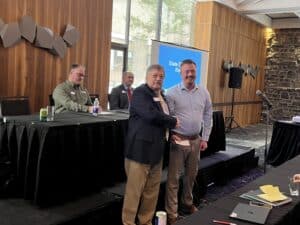
Uncrewed Aerial Application Systems Committee: An AGDISP modernization project was discussed in length, particularly with pesticide manufacturers on the committee, to see if resources might be forthcoming to aid in completing the recoding. It was also mentioned that another drone application organization was formed known as the American Spray Drone Coalition. Its current objective is advocating against the Countering CCP (Chinese Communist Party) Drones Act, seeking to ensure access to affordable, quality UAAS as the industry navigates toward a more U.S.-manufactured or U.S.-ally-manufactured UAAS. An ad hoc committee, part of the full UAAS committee is currently working on communication pieces designed to ensure drone users are aware of licensing and regulatory requirements and the legal and potentially criminal liability that one ignoring such requirements might face.
Budget & Finance and Membership Committee: The NAAA Board approved its budget for fiscal year 2025-2026 with expenses totaling $3,066,426 and a projected deficit of $208,720. Due to imperative and expensive projects underway by the association, such as the industry census and survey and recoding of the AGDISP atmospheric drift model, totaling over $700,000 to complete and both crucial to registering pesticides for aerial use, the NAAA Board also agreed to raise pilot member dues to $350 and other membership category dues by 8% to finance these projects. The dues increase will take place July 1st of this year.

National Agricultural Aviation Research & Education Foundation (NAAREF): In addition to developing PAASS curriculum and numerous other education related topics, NAAREF will be offering a safety session on turning safely presented by Fran de Kock of Battlefords Airspray. The session will be held on Saturday morning, Nov. 15, 2025.
State and Regional Reports: The North Carolina Agricultural Aviation Association gave thanks to NAAA members, many on the board, for donating to the Hurricane Helene relief effort. The Minnesota Agricultural Aviation Association presented a check to NAAREF in memory of ag pilot Craig Oleen after his passing and memorial donations that they received. The Nebraska Aviation Trades Association and the Illinois Agricultural Aviation Association also provided generous donations to NAAREF on behalf of their state associations.
It was a successful meeting and the NAAA Board continues to keep the association and the industry well prepared for challenges that face the U.S. aerial application industry in both the short term and the long term.
Ray Starling to Speak at 2025 Ag Aviation Expo Kickoff Breakfast

NAAA is pleased to announce the 2025 Ag Aviation Expo Kickoff Breakfast speaker, Ray Starling, whose roots run deep in agricultural politics. Starling had his pulse on agricultural issues during President Trump’s first term serving as his principal agriculture advisor at the White House and as chief of staff to U.S. Secretary of Agriculture Sonny Perdue where he coordinated the execution of the Secretary’s policy agenda for the U.S. Department of Agriculture, a $140 billion agency with more than 100,000 employees. He focused on regulatory and deregulatory initiatives and acted as a point of contact for stakeholders throughout agriculture and rural communities.
In the fall of 2022, Starling released his book Farmers Versus Foodies, in which he shares some perspective on the question of who will call the shots for the future of the farming and food system in the United States and beyond. He’ll also share his insights of what is in store for the U.S. agricultural sector during Trump’s second term. Currently, he serves as the chief counsel for the North Carolina Chamber of Commerce. He cut his teeth in the Tar Heel state serving as chief of staff and chief counsel for U.S. Sen. Thom Tillis after serving as general counsel when Tillis was Speaker of the House in the North Carolina legislature. He also worked as general counsel for the N.C. Department of Agriculture and Consumer Services, interfacing daily with Commissioner Steve Troxler.
Starling has taught numerous agricultural and food law courses. He grew up on a Century Family Farm in southeastern North Carolina and credits that experience as having more to do with his career path than any other influence or opportunity. His parents and eldest brother continue to farm. Starling was a National FFA Officer and is a former 4-H member. Attendee registration will open in July.
Air Tractor the Leading Global Producer of Turboprop Aircraft
According to the General Aviation Manufacturing Association (GAMA), Air Tractor, Inc. is the world’s top producer of general aviation turboprop airplanes. In its 2024 Aircraft Shipment and Billing Report, GAMA listed Air Tractor with 210 turboprop aircraft, with plans to produce 215 aircraft in 2025.
The milestone comes as Air Tractor concluded its 50th anniversary celebration in 2024. Since its founding, the company has remained focused on manufacturing purpose-built, reliable aircraft designed for aerial application, firefighting, and specialized applications.
“In recent years, the demand for Air Tractor aircraft has steadily risen, particularly internationally,” said Jim Hirsch, Air Tractor president. “We are proud of our contributions to efficiency, productivity, and safety in both our agricultural market and the firefighting sector. Our team remains committed to meeting the growing global demand while maintaining the high standards that define Air Tractor.”
Air Tractor stated that a key contributor to its success is the longstanding partnership with Pratt & Whitney Canada, the manufacturer of the PT6 turboprop engines that power Air Tractor aircraft.
“The strong relationship between Air Tractor and Pratt & Whitney Canada has been instrumental in delivering high-quality aircraft to our customers for 50 years now,” Hirsch said. “This partnership has played a significant role in making Air Tractor the industry leader it is today and ensures that every aircraft we produce is equipped with a dependable turboprop engine our customers can rely on.”
Ag Aviation’s Total Accident Rate Continues to Decline but Fatal Accident Rate Holds Level
The results from the 2023 FAA General Aviation and Part 135 Activity Survey (GA Survey) have been released. Ag aviators flew a total of 1,108,645 hours in 2023, an increase from the 831,999 hours flown in 2022. There were 60 ag aviation accidents, including 12 fatal accidents, in 2023. The overall ag aviation accident rate in 2023 was 5.41 accidents per 100,000 ag hours flown. The 2023 fatal ag aviation accident rate was 1.08 fatal ag aviation accidents per 100,000 flown.
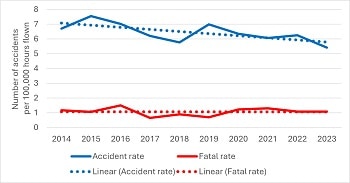
The addition of the 2023 GA survey data shows that ag aviation accident trends continue to follow the pattern described in the Winter 2025 issue of Agricultural Aviation. The total accident rate continues to decline while the fatal accident rate remains level, as shown in the figure below. Since PAASS began in 1999, the overall ag accident rate has declined by 27.3%. The fatal ag aviation accident rate has declined 5.2% since PAASS began.
The 2023 accident rate for the remainder of general aviation (excluding part 135) was lower than ag aviation’s rate at 4.55 accidents per 100,000 hours flown. General aviation’s 2023 fatal accident rate was 0.74 fatal accidents per 100,000 hours flown, which is also lower than ag aviation’s fatal accident rate.
The 2024 GA Survey data collection has already begun. Please help our industry and aviation in general by providing accurate information to the FAA if you are invited to participate.
NAAA Staff Member Amy May recognized with Distinguished Service Award at NATA
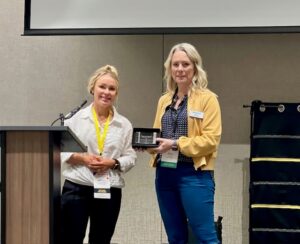
Nebraska Aviation Trades Association (NATA) supporter, and NAAA staff member, Amy May, was honored this week with NATA’s Distinguished Service Award, which is presented by the association’s president each year. Amy was awarded for her contributions to NATA. Amy and her husband, Tom, have been longtime members and supporters of NATA.
Amy is also an Athena Project presenter, which is a program presented at state/regional association meetings to educate and support those who have a connection to agricultural aviation by addressing the real risk management concerns of everyday life in the industry. Amy also participates as a Support Athena Committee member developing Athena content. Congratulations, Amy!
Nominations Open for the 2025 NAAA Awards!
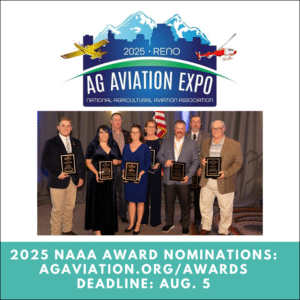
Do you have a rising pilot within your ranks? Do you admire certain NAAA members’ outstanding service to the industry or their community? The aerial application industry is filled with exceptional people who go above and beyond the call of duty, often with little fanfare. Make someone’s day or year by nominating them for a 2025 NAAA Award.
NAAA’s online submission form is easy and quick to use; nominate someone in just a few clicks here.
There are eight NAAA Award categories and one NAAREF Award. While the nomination deadline is August 5, early submissions are recommended to avoid missing the deadline as the summer season kicks in.
NAAA Award Categories
- Agrinaut Award: Honors an agricultural aircraft operator, operating organization, or allied member company that has made an outstanding contribution in the field of ag aircraft operations. The achievement cited shall have contributed to the “state-of-the-art” for the benefit of the agricultural aircraft industry as a whole.
- Delta Air Lines “Puffer” Award: Recognizes an individual who has made an outstanding contribution to the design of agricultural aircraft and/or related equipment.
- Evans-Christopher Operation S.A.F.E. Award: Recognizes individuals or entities that have made outstanding contributions to the Operation S.A.F.E. program. (Presented by NAAREF.)
- John Robert Horne Memorial Award: Honors a pilot with five or fewer years of experience in the agricultural aviation industry who has an exemplary safety record and has contributed to safety in ag aviation. This award no longer has carryover nominations from year to year; a new nomination must be submitted every year.
- Larsen-Miller Community Service Award: Recognizes outstanding contributions by a member to his or her community.
- Opal and Bill Binnion Memorial Award: Acknowledges those who contribute to NAAA in its efforts to educate the public about aerial application.
- Richard “Dick” Reade Allied Memorial Award: Presented to an NAAA members or staff and/or an allied industry individual who has significantly contributed their efforts for the benefit of the allied industry and the aerial application industry.
- William O. Marsh Safety Award: Recognizes significant achievements in safety, safety education or an outstanding operational safety program.
- Zoren and Joan O’Brien Memorial Outstanding Service Award: Awards outstanding service to the commercial agricultural aviation industry or to its association.
The 2025 NAAA Award recipients will be honored at the Excellence in Ag Aviation Banquet on Nov. 19 in Reno, NV.
AD Issued for Various Piper Models’ Rudder Post
The FAA has issued a new Airworthiness Directive (AD) for certain models of Piper aircraft which are not equipped with a rudder having a chromoly rudder post.
This AD was prompted by reports of two non-fatal accidents (PA-12, PA-14) that were caused by broken rudder posts that structurally failed above the upper hinge in flight. The National Transportation Safety Board (NTSB) published the report Structural Failure of Piper Part Number 40622 Rudder Posts Made of 1025 Carbon Steel (NTSB/AIR-22-02, January 2022) investigating these two accidents.
Before 1974, all rudders installed on Piper aircraft were equipped with 1025 carbon steel rudder posts. Starting in 1974, the rudder posts were manufactured from 4130N low-alloy steel (chromoly). The NTSB determined that the broken rudder posts resulted from the combination of fatigue loading and corrosion affecting the rudder assemblies made from 1025 carbon steel. The NTSB report included Safety Recommendation A-22-3 to the FAA to issue an AD requiring the replacement of rudders equipped with 1025 carbon steel rudder posts with rudders equipped with chromoly rudder posts.
This AD does not include PA-25 (Pawnee) or PA-36 (Pawnee Brave) models in its effectivity, however, NTSB provided comment on this AD when it was proposed, urging FAA to include PA-25 model aircraft in its effectivity, stating that it is likely affected by the same issue. FAA did not include the PA-25 in the final AD because the PA-25 type certificate was sold to a company in Argentina (Latinoamericana de Aviación S.A.). FAA plans to work with Argentina’s civil aviation authority to ensure this issue is addressed with the PA-25.
To Pawnee operators reading this, now is the time to check to ensure your rudder is equipped with a chromoly rudder post. Piper Service Bulletin 1379B (May 2024) specifies a procedure to determine if it is affected.
AD 2025-02-11 is effective March 20, 2025
In Case You Missed Last Week’s NAAA eNewsletter
Click here for the February 13, 2025 eNewsletter to read:
- Membership Grace Period Ends Saturday—Renew Your NAAA Membership Today
- NAAA Members Inspire Future Ag Aviators at California Aeronautical University Aviation Career Day
- Congratulations to Newest NAAA/Syngenta Leadership Training Program Graduates
- FAA’s GA Survey Data Collection for 2024 is Now Underway
- The Last Pass Memorial Walk Needs Your Help!
- NAAA & NAAREF Committee & Board Meetings in Montreal, Quebec, Canada Begin Next Week

